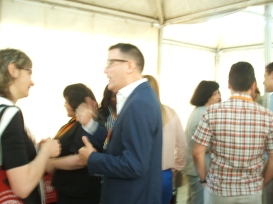Divergent Thoughts
How to take what you know and share it…
Four Quadrants: icebreaker for large groups
Posted by on June 11, 2015
Facilitated a workshop on Communication for Development* in Dhaka a week ago and came away with new insights on tried and tested facilitation methods. I’ll be sharing them here over the next few weeks.
A common thread in this type of workshop is the diversity of participants in terms of culture, ethnicity, organizational ethics and hierarchical levels.
When facilitating sessions such as these, I’m always ready to level the playing field, although I have learnt, it takes baby steps. A good litmus test is in the use of an icebreaker early in the workshop. Icebreakers have often been misunderstood as frivolous, playful getting-to-know-you sessions that have no real bearing in a proper conference. However, that perception is changing and I’m glad I don’t hear too many objections to them these days.
Icebreakers are there for a reason. When people are thrown together in a workshop, it is hard to expect them to collaborate like a well-oiled machine without some effort to bind them first. A good icebreaker can put people at ease, set the tone for informal collaboration and improve group dynamics quickly.
So how do you pick one that’s right for the occasion?
Think about the number of participants, their diverse backgrounds and fitness levels. These all determine the success of the icebreaker. The fun component comes in when people are happy to get to know each other and this is what should be foremost in your mind when choosing your icebreaker.
For this workshop, I used Four Quadrants, a great tool for large groups (anywhere from 30 – 100) that can be conducted in 30 minutes with minimal preparation.
In a Nutshell:
- Paste four corners of a large empty room with these qualifiers: Passion / Like / Tolerate / Dislike
- Ask participants to crowd around the middle of the room and using a microphone, ask them what they think of a specific activity. E.g., listening to classical music?
- Tell them to move to a corner (quadrant) that best reflects how they feel about the activity.
- Once people have settled in specific quadrants, look around for the quadrant with the least number of people (the minority) and ask a volunteer to tell you why she stands there. Get several viewpoints from the other quadrants.
- Repeat a few times with other questions: travelling on a train; watching movies etc.
Why use Four Quadrants?
- It is a fairly simple tool that does not ask too much of participants in terms of activity or movement, but engages them enough to have interesting, stimulating conversations.
- It is a great way for participants to quickly identify with others, despite their obvious differences.
- You can introduce questions on the workshop theme and gauge their perceptions on it. Keep this to a minimum though as some participants may not be comfortable sharing their views on a work-related issue.
Photos: Before….and After!
The questions are key to getting people comfortable, nothing too serious or obtuse, stick to general questions that elicit strong reactions from people in a fun way. I asked my 70-80 participants what they thought of sci-fi movies, and that generated very diverse quadrants with surprising responses. In 30 minutes, what had begun as a serious meeting introduction became a lively gathering of people, smiling and having fun. No stuffy coats to be seen anywhere!
*Hosted by UNICEF and BRAC International, the strategic planning workshop sought to strengthen Communication for Development support to improve education access in 15 countries across Asia, Africa, Latin America and Eastern Europe.


Recent Comments